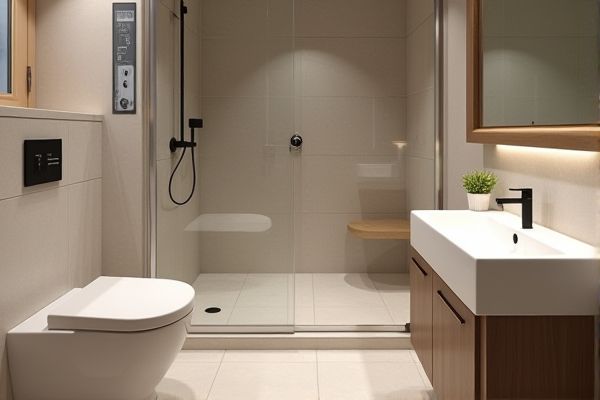
Smart toilets offer advanced features like automatic flushing, heated seats, and bidet functions that enhance comfort and hygiene compared to traditional toilets. Discover how upgrading Your bathroom with a smart toilet can transform Your daily routine by reading the rest of the article.
Table of Comparison
| Feature | Smart Toilet | Traditional Toilet |
|---|---|---|
| Technology | Advanced sensors, automatic flushing, heated seats, bidet functions | Basic flushing mechanism, manual operation |
| Hygiene | Self-cleaning, antibacterial surfaces, hands-free operation | Manual cleaning, higher risk of bacterial contamination |
| Water Efficiency | Dual flush, water-saving modes | Single flush, less water efficient |
| Comfort | Heated seats, adjustable temperature and pressure | No temperature control, basic seat comfort |
| Price | High initial cost, expensive installation | Affordable, widely available |
| Installation | Requires professional installation, electrical connection | Simple installation, no electricity needed |
| Maintenance | Regular software updates, potential electronic repairs | Minimal, mainly plumbing maintenance |
| Features | Remote control, air drying, deodorizing, night light | Basic flushing function only |
Introduction to Smart Toilets vs Traditional Toilets
Smart toilets feature advanced technology such as bidet functions, heated seats, automatic flushing, and air purification, enhancing hygiene and comfort beyond the basic design of traditional toilets. Traditional toilets rely on manual flushing, simple water storage tanks, and lack integrated sanitation features, making them less efficient and convenient than smart models. Your bathroom experience improves significantly with smart toilets by offering personalized settings and water-saving technology that traditional toilets cannot match.
Key Features of Smart Toilets
Smart toilets feature advanced functions such as automatic flushing, heated seats, and adjustable water pressure for personalized cleaning. Integrated sensors enable touchless operation and bidet functionalities, promoting enhanced hygiene compared to traditional toilets. With energy-saving modes and air purifiers, smart toilets provide a more comfortable and efficient bathroom experience tailored to your needs.
Design and Aesthetics Comparison
Smart toilets feature sleek, modern designs with integrated technology such as touchless controls, LED lighting, and minimalist profiles that enhance bathroom aesthetics and promote a futuristic ambiance. Traditional toilets maintain classic shapes and functionality, often prioritizing practicality over style, with bulkier designs and visible plumbing components. The seamless integration of smart toilets into contemporary bathroom decor offers a cleaner, more sophisticated appearance compared to the conventional look of traditional models.
Hygiene and Sanitation Advantages
Smart toilets improve hygiene and sanitation by incorporating advanced features such as self-cleaning nozzles, UV sterilization, and automatic flushing, reducing the risk of bacterial contamination compared to traditional toilets. Enhanced bidet functions offer customizable water temperature and pressure, promoting thorough cleaning without the need for toilet paper, which lowers the spread of germs and enhances personal hygiene. Sensor-operated lids and touchless controls further minimize physical contact with surfaces, significantly decreasing the transmission of pathogens in comparison to conventional manual toilets.
Water and Energy Efficiency
Smart toilets utilize advanced sensors and dual-flush systems to significantly reduce water consumption compared to traditional toilets, which often use a fixed amount of water per flush. Energy-efficient features such as heated seats and automatic lids operate on low power, optimizing energy use without compromising comfort. Your choice of a smart toilet can lead to substantial savings in both water bills and electricity usage over time.
Installation and Maintenance Requirements
Smart toilets typically require professional installation due to their advanced electronic features, including bidet functions, heated seats, and integrated sensors, whereas traditional toilets have simpler setups manageable by most homeowners. Maintenance for smart toilets involves regular software updates, sensor calibration, and potential electrical repairs, contrasting with traditional toilets that mainly need occasional plumbing fixes and cleaning. The complexity of smart toilet systems can increase long-term maintenance costs compared to the straightforward upkeep of conventional models.
User Comfort and Accessibility
Smart toilets enhance user comfort and accessibility through features like heated seats, customizable water temperature, and automated lid operation, catering especially to individuals with limited mobility or disabilities. Traditional toilets lack these adaptive functions, offering a basic experience without personalized settings. Your daily bathroom routine becomes more convenient and hygienic with a smart toilet's advanced technology tailored to individual needs.
Cost Analysis: Upfront and Long-Term
Smart toilets have a higher upfront cost, typically ranging from $1,000 to $6,000, compared to traditional toilets priced between $100 and $500. Long-term expenses for smart toilets include maintenance of electronic components and potential software updates, while traditional toilets generally incur lower ongoing costs focused on water usage and occasional repairs. Energy-efficient smart models can reduce water consumption, potentially offsetting higher initial investments through utility savings over time.
Environmental Impact of Both Options
Smart toilets significantly reduce water consumption by using advanced flushing technology that adapts to waste type, saving thousands of gallons annually compared to traditional toilets, which often use fixed, higher flush volumes. These eco-friendly features minimize environmental impact by lowering water wastage, reducing strain on sewage systems, and decreasing energy usage associated with water treatment. Your choice of a smart toilet supports sustainable living through efficient resource use and less environmental degradation.
Which Toilet is Right for You?
Smart toilets offer advanced features like heated seats, automatic flushing, and bidet functions, enhancing hygiene and comfort compared to traditional toilets. Traditional toilets provide simplicity, lower initial costs, and easier maintenance, making them suitable for basic needs and tighter budgets. Choosing between the two depends on prioritizing convenience and technology versus affordability and straightforward functionality.
 homyna.com
homyna.com